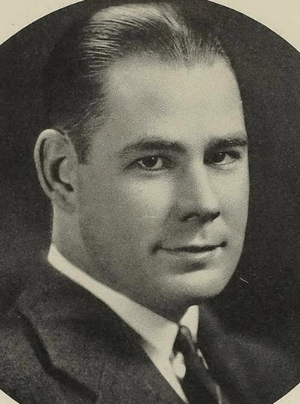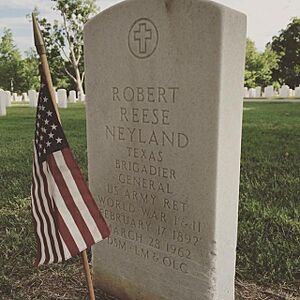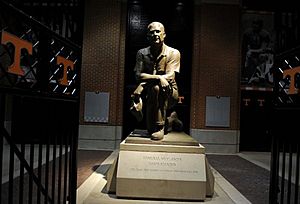Robert Neyland facts for kids

Neyland from the 1940 Volunteer
|
|
| Biographical details | |
|---|---|
| Born | February 17, 1892 Greenville, Texas, U.S. |
| Died | March 28, 1962 (aged 70) New Orleans, Louisiana, U.S. |
| Playing career | |
| 1913–1916 | Army |
| Position(s) | Lineman |
| Coaching career (HC unless noted) | |
| 1919–1924 | Army (assistant) |
| 1925 | Tennessee (assistant) |
| 1926–1934 | Tennessee |
| 1936–1940 | Tennessee |
| 1946–1952 | Tennessee |
| Administrative career (AD unless noted) | |
| 1936–1941 | Tennessee |
| 1946–1962 | Tennessee |
| Head coaching record | |
| Overall | 173–31–12 |
| Bowls | 2–5 |
| Accomplishments and honors | |
| Championships | |
| 4 National (1938, 1940, 1950, 1951) 2 SoCon (1927, 1932) 5 SEC (1938–1940, 1946, 1951) |
|
| Awards | |
| Amos Alonzo Stagg Award (1957) 4× SEC Coach of the Year (1936, 1938, 1950, 1951) |
|
| College Football Hall of Fame Inducted in 1956 (profile) |
|
Robert Reese Neyland (pronounced KNEE-lənd; February 17, 1892 – March 28, 1962) was a famous American football coach and a high-ranking officer in the United States Army. He became a brigadier general. Neyland coached football at the University of Tennessee (UT) three different times: from 1926 to 1934, 1936 to 1940, and 1946 to 1952.
He is one of only two college football coaches to win national championships in two separate periods at the same school. Neyland holds the record for the most wins in Tennessee Volunteers history, with 173 victories in 216 games. His teams had six perfect seasons and won four national championships. He also led the Vols to amazing winning streaks, including 33, 28, 23, 19, and 14 games without a loss.
Neyland is often called one of the greatest defensive football coaches ever. Sports Illustrated even named him the defensive coordinator for its all-century college football team. A remarkable 112 of his wins were shutouts, meaning the other team scored no points. In 1938 and 1939, his teams set a record by shutting out 17 opponents in a row during regular seasons. His 1939 team is the last college team to keep every regular season opponent from scoring.
Neyland was also a forward-thinker. He was one of the first coaches to use sideline telephones and game film to study opponents. His teams also wore lighter pads and jerseys that were easier to tear away. These ideas helped his players move faster, showing Neyland's belief in "speed over strength." He is also famous for creating seven "Game Maxims" for football, which many coaches still use today. Tennessee players still say these maxims before every game.
Neyland Stadium at UT is named after him and was even designed by him. His original plans were used for all the stadium's expansions, making it huge with over 100,000 seats. Neyland was added to the College Football Hall of Fame in 1956.
On November 12, 2010, a large bronze statue of General Neyland was put up at Neyland Stadium. The statue is 9 feet tall and weighs almost 1,500 pounds. It shows Neyland kneeling, and his famous seven Game Maxims are carved into its base.
Contents
Early Life and College Days
Robert Neyland was born in Greenville, Texas. He went to Burleson Junior College and then to Texas A&M University. Later, he got a special invitation to the United States Military Academy at West Point, New York.
At West Point, Neyland was a star athlete. He played as a lineman in football and was a pitcher in baseball. He was also the academy's boxing champion. He was so good at baseball that the National League's New York Giants offered him a $3,500 contract, but he chose to stay in the Army.
Neyland graduated from West Point in 1916. He became an officer in the United States Army Corps of Engineers and served in France during World War I. After the war, he studied engineering at Massachusetts Institute of Technology (MIT). Then he returned to West Point to work for Superintendent Douglas MacArthur.
Coaching Football at Tennessee
In 1925, Captain Neyland wanted to keep coaching. He became a Professor of Military Science at the University of Tennessee (UT). After one year as an assistant coach, he became the head coach and athletic director in 1926.
He coached the team for nine years. During this time, his teams had five perfect seasons. They also had amazing winning streaks of 33 and 28 games. The Army then called him away for a year to serve in Panama. When he returned, he came back to UT as head coach.
His 1938 team went undefeated and was called a national champion. His 1939 team is famous for being the last college football team to go a whole regular season without letting any opponent score. From November 1938 to December 1939, his teams had 17 straight shutouts. This means they kept the other team from scoring for 71 quarters in a row, which is a record that still stands! He had another undefeated regular season in 1940.
He was called back to military service in 1941 for World War II. He served in the China-Burma-India area, helping to move supplies. He received several important awards for his service.
Neyland retired from the military again in 1946 as a brigadier general. He returned to coach the Vols until 1952. His 1950 team was named a national champion, and his 1951 team won the school's first official national championship. He stayed as the athletic director until he passed away in New Orleans in 1962.
Neyland Stadium: His Legacy
Before he died, Neyland drew up plans to make the Vols' home stadium, Shields–Watkins Field, much bigger. When he first arrived in 1925, the stadium only held 3,200 people. By the time he passed away, it could hold over 46,000 fans!
In 1962, the university renamed the stadium Neyland Stadium in his honor. The plans he made were so good that they have been used for every major expansion of the stadium since then.
Neyland's Famous Football Rules
In the 1930s, Neyland started having his teams say seven sentences before games. He believed these sentences summed up how to win. They became known as "the Seven Maxims of Football" or "the Seven Game Maxims."
- The team that makes the fewest mistakes will win.
- Play for and make the breaks and when one comes your way – SCORE.
- If at first the game – or the breaks – go against you, don't let up... put on more steam.
- Protect our kickers, our QB, our lead and our ball game.
- Ball, oskie, cover, block, cut and slice, pursue and gang tackle... for this is the WINNING EDGE.
- Press the kicking game. Here is where the breaks are made.
- Carry the fight to our opponent and keep it there for 60 minutes.
The Neyland Scholarship Fund
In 1961, Neyland started planning a way for supporters of UT sports to also help the school's academic programs. He wanted to create scholarships to bring excellent students to the university. General Neyland himself was a great student as well as an athlete. He dreamed that UT would offer four-year scholarships to students with strong academics and leadership skills.
After Neyland's death in 1962, the UT president, Dr. Andrew D. Holt, announced a plan to raise money for the Robert R. Neyland Scholarship Fund. The first Neyland Scholarships were given out in 1963 to Melissa Ann Baker and Robert English Allen.
His Family

On July 16, 1923, Robert Neyland married Ada "Peggy" Fitch. They had two sons, Robert Jr. and Lewis. Both General Neyland and Ada are buried in the Knoxville National Cemetery.
See also
- List of college football head coaches with non-consecutive tenure




